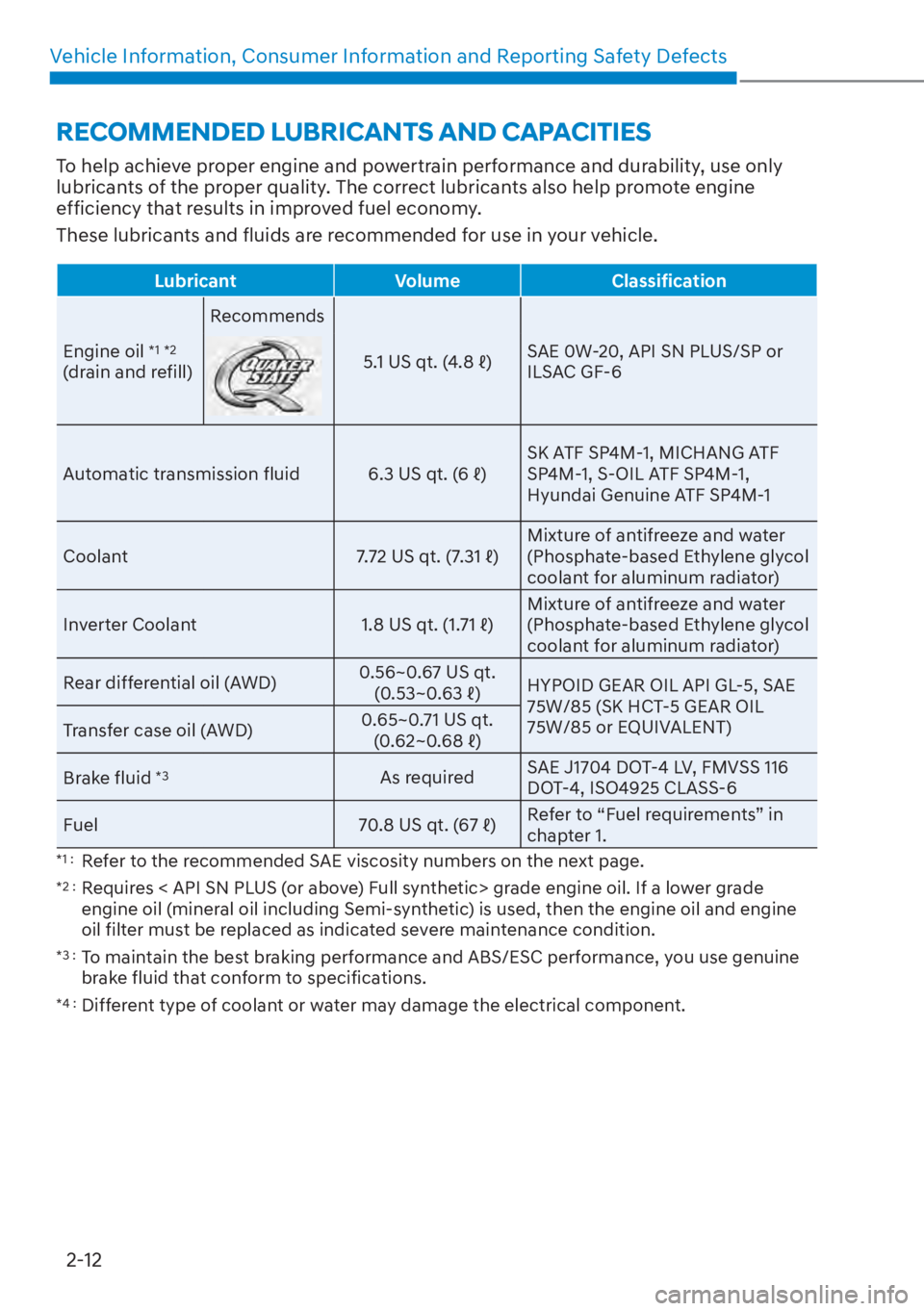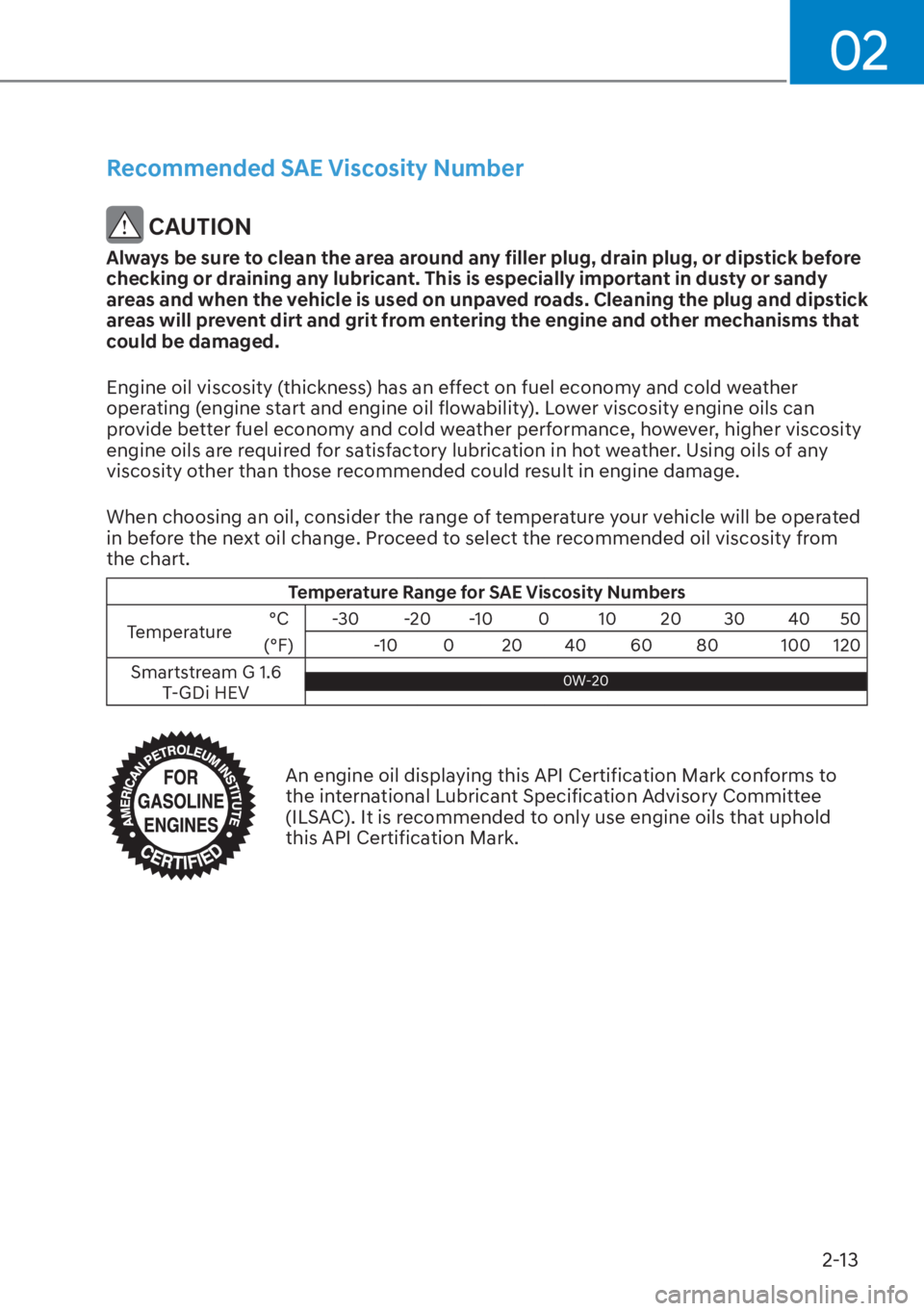Page 41 of 623

Vehicle Information, Consumer Information and Reporting Safety Defects2-12
To help achieve proper engine and powertrain performance and durability, use only
lubricants of the proper quality. The correct lubricants also help promote engine
efficiency that results in improved fuel economy.
These lubricants and fluids are recommended for use in your vehicle.
Lubricant VolumeClassification
Engine oil
*1 *2
(drain and refill) Recommends
���������8�6���T�W���������������b�� SAE 0W-20, API SN PLUS/SP or
ILSAC GF-6
Automatic transmission fluid
���������8�6���T�W�����������b��SK ATF SP4M-1, MICHANG ATF
SP4M-1, S-OIL ATF SP4M-1,
Hyundai Genuine ATF SP4M-1
Coolant �����������8�6���T�W�����������������b��Mixture of antifreeze and water
(Phosphate-based Ethylene glycol
coolant for aluminum radiator)
Inverter Coolant ���������8�6���T�W�����������������b��Mixture of antifreeze and water
(Phosphate-based Ethylene glycol
coolant for aluminum radiator)
Rear differential oil (AWD) 0.56~0.67 US qt.
�����������a�����������b�� HYPOID GEAR OIL API GL-5, SAE
75W/85 (SK HCT-5 GEAR OIL
75W/85 or EQUIVALENT)
Transfer case oil (AWD) 0.65~0.71 US qt.
�����������a�����������b��
Brake fluid
*3As required SAE J1704 DOT-4 LV, FMVSS 116
DOT-4, ISO4925 CLASS-6
Fuel �����������8�6���T�W�������������b��Refer to “Fuel requirements” in
chapter 1.
*1 : Refer to the recommended SAE viscosity numbers on the next page.
*2 : Requires < API SN PLUS (or above) Full synthetic> grade engine oil. If a lower grade
engine oil (mineral oil including Semi-synthetic) is used, then the engine oil and engine
oil filter must be replaced as indicated severe maintenance condition.
*3 : To maintain the best braking performance and ABS/ESC performance, you use genuine
brake fluid that conform to specifications.
*4 : Different type of coolant or water may damage the electrical component.
RECOMMENDED LUBRICANTS AND CAPACITIES
Page 42 of 623

02
2-13
Recommended SAE Viscosity Number
CAUTION
Always be sure to clean the area around any filler plug, drain plug, or dipstick before
checking or draining any lubricant. This is especially important in dusty or sandy
areas and when the vehicle is used on unpaved roads. Cleaning the plug and dipstick
areas will prevent dirt and grit from entering the engine and other mechanisms that
could be damaged.
Engine oil viscosity (thickness) has an effect on fuel economy and cold weather
operating (engine start and engine oil flowability). Lower viscosity engine oils can
provide better fuel economy and cold weather performance, however, higher viscosity
engine oils are required for satisfactory lubrication in hot weather. Using oils of any
viscosity other than those recommended could result in engine damage.
When choosing an oil, consider the range of temperature your vehicle will be operated
in before the next oil change. Proceed to select the recommended oil viscosity from
the chart.
Temperature Range for SAE Viscosity Numbers
Temperature °C -30 -20 -10 0 10 20 30 40 50
(°F) -10 0 20 40 60 80 100 120
Smartstream G 1.6 T-GDi HEV
0W-20 0W-20
An engine oil displaying this API Certification Mark conforms to
the international Lubricant Specification Advisory Committee
(ILSAC). It is recommended to only use engine oils that uphold
this API Certification Mark.
Page 344 of 623

06
6-55
Chain Installation
When installing tire chains, follow the
manuf
acturer’s instructions and mount
them as tightly possible. Drive slowly
(less than 20 mph (30 km/h)) with
chains installed. If you hear the chains
contacting the body or chassis, stop and
tighten them. If they still make contact,
slow down until the noise stops. Remove
the tire chains as soon as you begin
driving on cleared roads.
When mounting snow chains, park the
vehicle on level ground away from traffic.
Turn on the vehicle Hazard Warning
Flasher and place a triangular emergency
warning device behind the vehicle (if
available). Always place the vehicle in P
(Park), apply the parking brake and turn
off the engine before installing snow
chains.
NOTICE
When using tire chains:
�[�� Wrong size chains or improperly
installed chains can damage your
vehicle’s brake lines, suspension,
body and wheels.
�[�� Use SAE “S” class or wire chains.
�[�� If you hear noise caused by chains
contacting the body, retighten the
chain to prevent contact with the
vehicle body.
�[�� To prevent body damage, retighten
the chains after driving 0.3~0.6 miles
(0.5~1.0 km).
�[�� Do not use tire chains on vehicles
equipped with aluminum wheels. If
unavoidable, use a wire type chain.
�[�� Use wire chains less than 0.47 in.
(12 mm) thick or fabric-type chain
to prevent damage to the chain’s
connection.
�[�� Fabric-type chains must be used on
vehicles equipped with 19/20” tires.
Winter Precautions
Use high quality ethylene glycol coolant
Your vehicle is delivered with high
quality ethylene glycol coolant in the
cooling system. It is the only type of
coolant that should be used because it
helps prevent corrosion in the cooling
system, lubricates the water pump and
prevents freezing. Be sure to replace or
replenish your coolant in accordance
with the maintenance schedule in
chapter 9. Before winter, have your
coolant tested to assure that its freezing
point is sufficient for the temperatures
anticipated during the winter.
Check battery and cables
Winter temperatures affect battery
performance. Inspect the battery and
cables, as specified in chapter 9. The
battery charging level can be checked
by an authorized HYUNDAI dealer or in a
service station.
Change to “winter weight” oil if
necessary
In some regions during winter, it is
recommended to use the “winter
weight” oil with lower viscosity In
addition, replace the engine oil and filter
if it is close to the next maintenance
interval. Fresh engine oil ensures
optimum engine operation during the
winter months. For further information,
refer to chapter 2. When you are not sure
about a type of winter weight oil, you
consult an authorized HYUNDAI dealer.